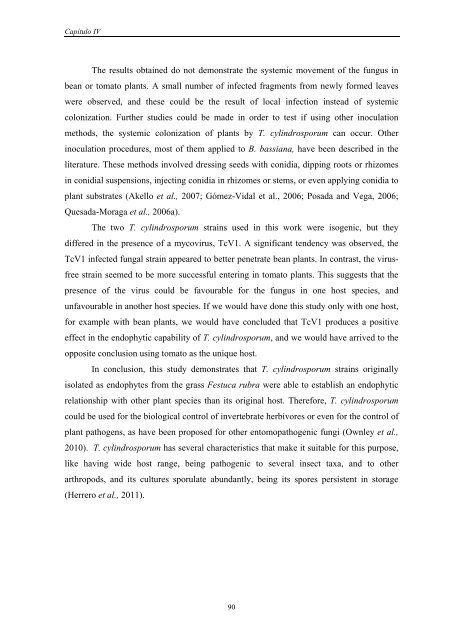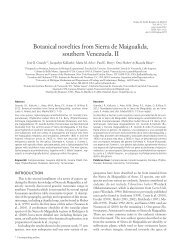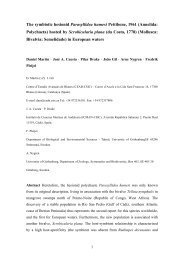TESIS NOEMI HERRERO.pdf - Consejo Superior de Investigaciones ...
TESIS NOEMI HERRERO.pdf - Consejo Superior de Investigaciones ...
TESIS NOEMI HERRERO.pdf - Consejo Superior de Investigaciones ...
Create successful ePaper yourself
Turn your PDF publications into a flip-book with our unique Google optimized e-Paper software.
Capítulo IV<br />
The results obtained do not <strong>de</strong>monstrate the systemic movement of the fungus in<br />
bean or tomato plants. A small number of infected fragments from newly formed leaves<br />
were observed, and these could be the result of local infection instead of systemic<br />
colonization. Further studies could be ma<strong>de</strong> in or<strong>de</strong>r to test if using other inoculation<br />
methods, the systemic colonization of plants by T. cylindrosporum can occur. Other<br />
inoculation procedures, most of them applied to B. bassiana, have been <strong>de</strong>scribed in the<br />
literature. These methods involved dressing seeds with conidia, dipping roots or rhizomes<br />
in conidial suspensions, injecting conidia in rhizomes or stems, or even applying conidia to<br />
plant substrates (Akello et al., 2007; Gómez-Vidal et al., 2006; Posada and Vega, 2006;<br />
Quesada-Moraga et al., 2006a).<br />
The two T. cylindrosporum strains used in this work were isogenic, but they<br />
differed in the presence of a mycovirus, TcV1. A significant ten<strong>de</strong>ncy was observed, the<br />
TcV1 infected fungal strain appeared to better penetrate bean plants. In contrast, the virusfree<br />
strain seemed to be more successful entering in tomato plants. This suggests that the<br />
presence of the virus could be favourable for the fungus in one host species, and<br />
unfavourable in another host species. If we would have done this study only with one host,<br />
for example with bean plants, we would have conclu<strong>de</strong>d that TcV1 produces a positive<br />
effect in the endophytic capability of T. cylindrosporum, and we would have arrived to the<br />
opposite conclusion using tomato as the unique host.<br />
In conclusion, this study <strong>de</strong>monstrates that T. cylindrosporum strains originally<br />
isolated as endophytes from the grass Festuca rubra were able to establish an endophytic<br />
relationship with other plant species than its original host. Therefore, T. cylindrosporum<br />
could be used for the biological control of invertebrate herbivores or even for the control of<br />
plant pathogens, as have been proposed for other entomopathogenic fungi (Ownley et al.,<br />
2010). T. cylindrosporum has several characteristics that make it suitable for this purpose,<br />
like having wi<strong>de</strong> host range, being pathogenic to several insect taxa, and to other<br />
arthropods, and its cultures sporulate abundantly, being its spores persistent in storage<br />
(Herrero et al., 2011).<br />
90

















